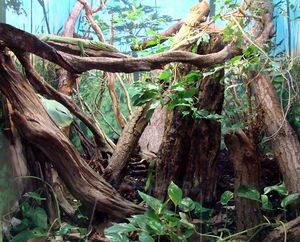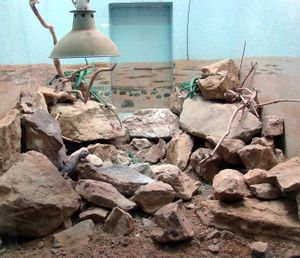Lizard Housing
| This article has been peer reviewed but is awaiting expert review. If you would like to help with this, please see more information about expert reviewing. |

Introduction
Most diseases of lizards in captivity are due to poor husbandry. Reptile Maladaption Syndrome has previously been seen as a disease where reptiles fail to adapt to life in captivity. In fact, it is a problem directly associated with poor husbandry, however subtle, and not a problem with the reptile. For example:
- Reptiles kept in an environment that is too cold may begin to regurgitate undigested food or will abstain from eating, eventually becoming ill and dying.
- If kept in humidity that is too high or too low, they may refuse to eat, have difficulties shedding, and may develop respiratory infections or skin lesions.
- Failure to duplicate appropriate photoperiods and temperature in captivity may result in compromising the reproductive cycles and reproduction could become sporadic or stop alltogether.
You will need to have a thorough understanding of the suitable environment and diet for diagnosis and treatment. The caging of lizards is often poorly understood by owners.
For information on species specific husbandry requirements, see Lizard Husbandry Requirements.
Visual security
A place to hide should be provided for all cage inhabitants. Many species refuse to eat and may become stressed if they lack a hiding place. If a lizard doesn't use its hiding place, something is wrong with the hiding place and a different size or shape should be tried.
Heat
Reptiles are ectothermic vertebrates that regulate body temperature by behavioural and physiological processes. Most species operate within a preferred optimum temperature zone (or POTZ) that, in the wild, shows seasonal variation. Knowing the POTZ is imperative for long-term captive maintenance since supplemental heating is necessary for captive lizards. Reaching their POTZ is necessary for optimum metabolic processes including digestion, growth, healing, reproduction and immune system function.
- Heat should be provided by a radiant source; a 60 to 100 watt incandescent bulb is usually adequate. Daytime temperatures of 29-32°C are optimal with a basking area around 5°C above this. Night temperatures can drop 5°C below the day temperature.
Most lizard species, such as iguanas, derive external heat from basking in the sun, not from laying on rocks heated by the sun. Exposure to temperatures above the POTZ can result in localised burns, systemic effects and death. The most popular heat source, the hot rock, is therefore inappropriate for many species and may be dangerous.
Substrate
An ideal substrate is one that is absorbent, digestible if swallowed, inexpensive and aesthetically pleasing. Selection must be tailored to the particular needs of the individual species (e.g. burrowing or desert species may require sand which is usually not suitable for other species).
Suitable substrates may include newspaper, carpet, bark chips, pellets and mulch. Avoid gravel, crushed corn cob, kitty litter, wood shavings and substrates that can be ingested. A variety of broad limbs, rocks or pieces of bark should be provided as basking spots.
Light
See lighting requirements here.
The full spectrum of natural light is important for the health of lizards. Ultraviolet wavelengths are specifically important for vitamin D and calcium metabolism. There are two bands of UV: UVA and UVB. UVA (320-400nm) produces beneficial behavioural and psychological effects but does not activate vitamin D precursors in the skin. UVB (290-320nm) is necessary for vitamin D synthesis.
- A consistent photoperiod of 14 hours light and 10 hours dark is recommended. An ultraviolet light source should be available within two feet of the lizard (Note: UV light will not penetrate glass).
However, artificial lights cannot replace natural sunlight and even a few minutes of exposure to unfiltered sunlight is beneficial. Slow deliberate lizards may become far more active with a small amount of time in sunlight each day. Although artificial light provides UVB and vitamin D3 may be available as a supplement, there is no substitute for natural sunlight.
Enclosure
Lizards that are allowed to roam free in the house are subject to chilling (lack of access to a heat source, too much access to cold outside walls and windows, and draughts), trauma (stepped on, closed in doors, falling, attacked by cat/dog) and escape.
Ensure the enclosure is of the proper size and orientation (consider vertical height for arboreals, width and depth to enable proper thermoregulation, space for active and wide-ranging species and multiple inhabitants) and has doors large enough for access.
Water and humidity
Correct humidity and temperature is necessary to ensure proper ecdysis. High humidity and temperature can result in rapid growth of bacteria and mould in the cage but this can be prevented with adequate ventilation and hygiene.
Drinking water can be offered in bowls (which may also be used for bathing), by misting or a drip system. Chameleons do not drink from water bowls and require drip systems and species such as water dragons require water for submersion.
Literature Search
Use these links to find recent scientific publications via CAB Abstracts (log in required unless accessing from a subscribing organisation).
Hot or cold: the use of thermography in reptile husbandry and management. Fleming, G. J.; The North American Veterinary Conference, Gainesville, USA, Small animal and exotics. Proceedings of the North American Veterinary Conference, Orlando, Florida, USA, 17-21 January, 2009, 2009, pp 1781-1782, 13 ref. - Full Text Article

